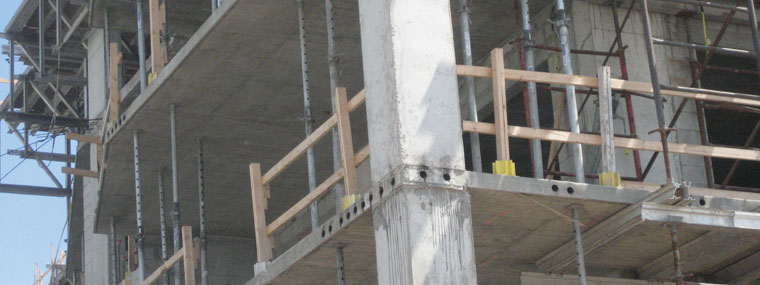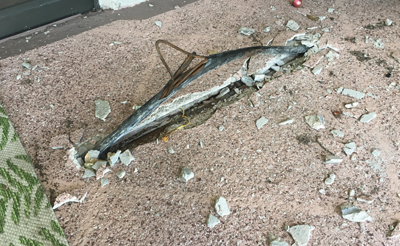
What to Know about Post-Tensioned Buildings
By Jim Emory, PE, SI, and CGC / Published September 2022

Many of the newer (since the early 1990s) coastal condominium buildings are constructed using post-tensioned (PT) cables. What are post-tension cables? Post-tension cables are high-tensioned strands running through the horizontal floor slabs in grease-filled vinyl sheathing. The cables are laid into the concrete forms according to the structural and PT design. The cables run throughout the slabs from one end of the building to the other in both directions, including to the exterior walls and balconies, and through the living area. Each floor level can have hundreds of post-tension cables.
 Once concrete is poured and has sufficiently cured, the cables are tensioned (thus the term “post” tensioned, after the concrete is cured) to about 33,000 pounds of tension each. The tension is locked off on the “live” end of the cable using an anchor head assembly and wedges set in a recessed core hole. The cable is then trimmed and capped, and the core hole is filled with grout and stuccoed over.
Once concrete is poured and has sufficiently cured, the cables are tensioned (thus the term “post” tensioned, after the concrete is cured) to about 33,000 pounds of tension each. The tension is locked off on the “live” end of the cable using an anchor head assembly and wedges set in a recessed core hole. The cable is then trimmed and capped, and the core hole is filled with grout and stuccoed over.
Post-tension buildings have become the favored method of construction for many condominium developers (as well as numerous other construction industry applications) due to their design parameters, allowing for much longer spans than comparable conventionally reinforced concrete; the thinner slabs offer less overall weight and concrete throughout the structure design. The result is preferred wide open floor plans and panoramic ocean views.
 Post-tension buildings are well-designed structures and can be extremely durable and strong. In fact, post-tension designs were originally considered to be permanent and thought to be “maintenance free”; it wasn’t until 2019 that the Post-Tensioning Institute released official guidelines and certifications for post-tension cable repairs. However, the corrosive environment of coastal salt air combined with exposed horizontal slabs (balconies) rather quickly developed the need for post-tension cable repairs, splicing, replacement, and/or re-tensioning.
Post-tension buildings are well-designed structures and can be extremely durable and strong. In fact, post-tension designs were originally considered to be permanent and thought to be “maintenance free”; it wasn’t until 2019 that the Post-Tensioning Institute released official guidelines and certifications for post-tension cable repairs. However, the corrosive environment of coastal salt air combined with exposed horizontal slabs (balconies) rather quickly developed the need for post-tension cable repairs, splicing, replacement, and/or re-tensioning.
In practice, not enough thought was given to the protection of the concrete surrounding the PT cables, especially the anchor head hardware and “back-up conventional steel” at the slab edges. Balcony floors were not adequately protected from the elements, including the coastal airborne chlorides from oceanfront salt spray. Balconies were, and still are in some cases, finished with outdoor carpet, tile, cementitious toppings, and other non-water-resistant finishes. This readily allowed saltwater to penetrate the concrete and cause corrosion to the PT anchor elements and backup reinforcing steel. Also contributing to the salt contamination were improperly designed/sealed penetrations in the slab for railing posts, shutter assemblies, screen frames, and even lower quality sliding glass door fasteners. In many cases, the shutters and/or screen frames blocked drainage off the balcony edge, allowing saltwater to sit and soak in for long periods of time. Additionally, by raising the height of the balcony surface, tile flooring can block the drainage away from the sliding glass door track.
 All of the above listed circumstances led to concrete spalling around the PT cable anchor heads, and in some cases, failure of the anchor. When a cable fails, the roughly 30,000 pounds of tension goes quickly to zero. That energy is forced to be released somewhere. As the example photos on pages 10 and 11 show, the cable can then break through the slab, floor, or ceiling, or even shoot out of the slab edge core hole. It can cause tile flooring to erupt in the unit. In some cases, the energy is contained within the slab. Many have described hearing a cable break as a sound that is similar to a gunshot.
All of the above listed circumstances led to concrete spalling around the PT cable anchor heads, and in some cases, failure of the anchor. When a cable fails, the roughly 30,000 pounds of tension goes quickly to zero. That energy is forced to be released somewhere. As the example photos on pages 10 and 11 show, the cable can then break through the slab, floor, or ceiling, or even shoot out of the slab edge core hole. It can cause tile flooring to erupt in the unit. In some cases, the energy is contained within the slab. Many have described hearing a cable break as a sound that is similar to a gunshot.
When there is spalling concrete around a PT cable, the tension of the cable must be relieved temporarily to allow the structural concrete repairs to be executed properly and safely. This must be done by experienced contractors and engineers. An unexpected cable break can cause loss of life or limbs. Once the concrete is repaired, the cable can generally be spliced and re-tensioned, or if needed, fully replaced.
Jim Emory
President and Principal Engineer, Keystone Engineering & Consulting
Jim Emory is president and principal engineer at Keystone Engineering & Consulting, which has repaired thousands of PT cables on condominium projects over the years. We have the expertise, credentials, and contractor base to take care of the repairs safely, and cost-effectively, in a long-term fashion. We can also evaluate your structure with a Phase I inspection process and determine the existing repair needs, as well as identify vulnerable aspects of the structure known to exacerbate spalling and PT cable damage. We can make recommendations for actions to minimize future building maintenance issues, costs, and inconvenience. Several Keystone personnel hold Post-Tensioning Institute credentials, including the principal engineer having the highest, Level II, credentials for both PT cable installation inspection and PT cable repairs.
For more information on post-tensioning in buildings and how to ensure the safety and value of your coastal property, contact Keystone Engineering & Consulting at keystoneengineeringpe.com/contact.asp.




